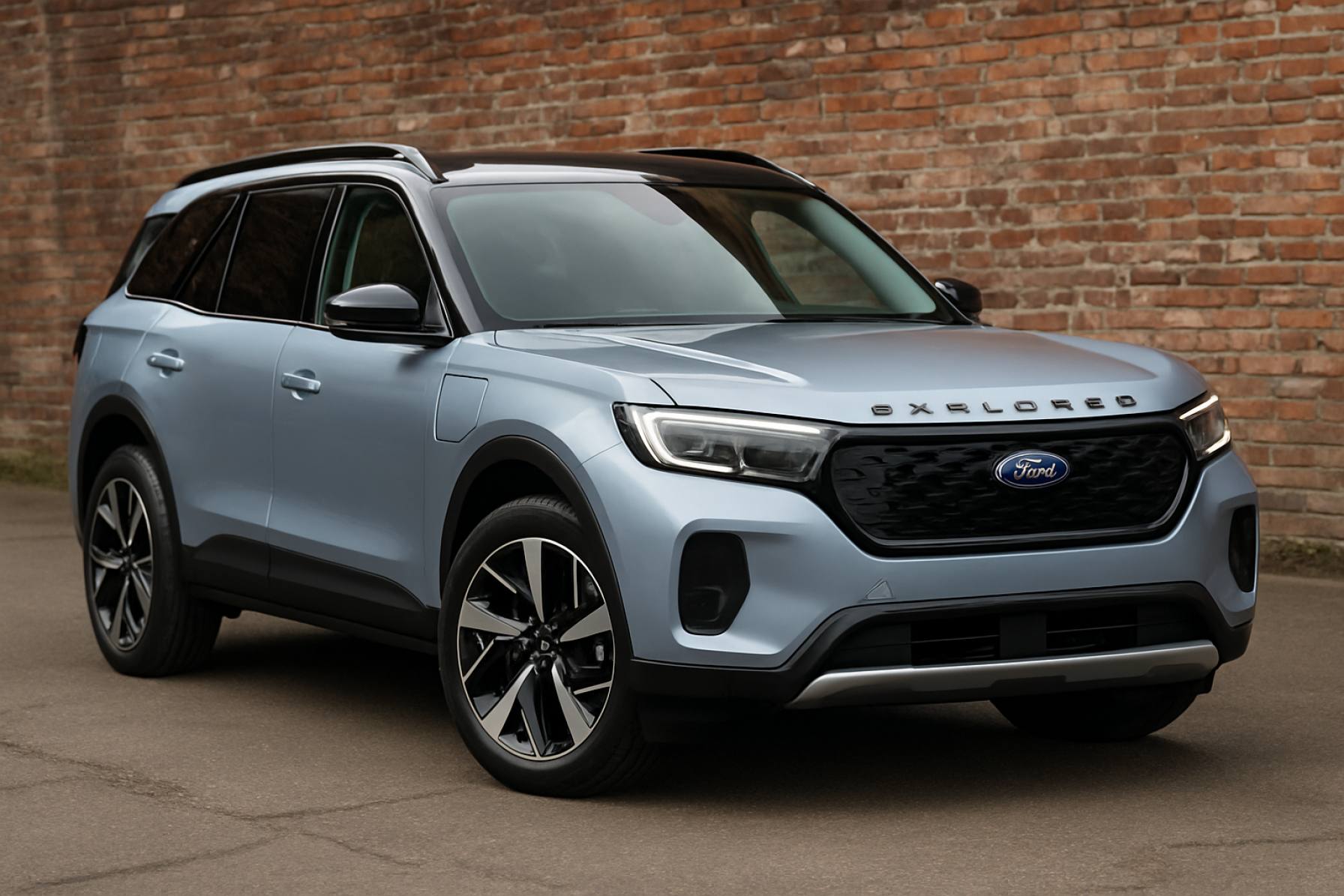- The new Ford Explorer EV stands out with bold American styling and innovative design, sharing roots with the Volkswagen ID.4 but exceeding it in character and excitement.
- Interior highlights include a large 14.6-inch portrait touchscreen, hidden storage, and a high standard of comfort and finish.
- The entry-level 52kWh battery offers 168bhp, agile rear-wheel-drive performance, and a practical 233-mile range—making it both fun and functional for daily and long-distance driving.
- Fast 145kW charging enables a 10% to 80% top-up in just 25 minutes, easing range anxiety and road trip planning.
- Generous standard features and competitive leasing options make the Explorer EV an affordable choice in the electric crossover segment.
- Ford’s Explorer EV blends style, value, and driving enjoyment—making it a standout alternative to rivals like the Volkswagen ID.4 and Skoda Enyaq.
Forget everything you thought you knew about Ford’s place in the electric car revolution. While household names like the Mustang Mach-E and the revived Capri have snatched the limelight, the new Ford Explorer quietly emerges as an unexpected hero, mixing clever design, driving fun, and eye-catching value.
Step inside the Explorer and it’s hard not to be impressed. Ford designers haven’t simply borrowed from their German colleagues – despite sharing underpinnings with the Volkswagen ID.4, the Explorer leaps ahead with distinctly American charisma. Imagine sliding into a cabin anchored by a towering 14.6-inch portrait touchscreen, its secret storage cubby hidden beneath, and you’ll understand why the interior feels fresh rather than familiar. The fit and finish are solid, blending comfort with a sense of adventure.
Beyond the cabin, the Explorer’s performance may surprise those who dismiss base models. The entry-level 52kWh battery variant delivers 168bhp and 310Nm of torque—enough punch to liven up the school run or make a weekend retreat enjoyable. Acceleration to 62mph clocks in at 8.7 seconds, but what’s more striking is how the rear-wheel-drive setup brings an agile, playful character, especially when carving through bends. It edges ahead of the Volkswagen ID.4 in terms of sheer driving excitement, no small feat in the EV landscape.
Range anxiety barely registers; the 52kWh battery serves up a practical 233 miles on a single charge, making it an adept commuter and road-trip companion. And when you do need to top up, the Explorer’s 145kW rapid charging means a 10% to 80% boost takes just 25 minutes—less time than it takes for your coffee break to end at a busy motorway service station.
Practicality hasn’t been sacrificed for pleasure. Even as a base Style trim, the Explorer ships out with 19-inch alloys, dazzling LED lighting, a rear-view camera, and dual-zone air conditioning—all standard. Ford tailors its offering to modern needs with a competitive lease price: £228 a month over two years (with a £3,003 deposit), and 5,000 miles each year included—a figure that can easily rise to 10,000 miles for a modest uplift.
In a field crowded by competent but sometimes uninspiring competitors like the Volkswagen ID.4 and Skoda Enyaq, the Explorer injects personality and genuine value. Ford’s recent EV foray is not just about electrification—it’s a statement that the Blue Oval brand still knows how to make a car you’ll look forward to driving and living with every day.
The key takeaway? Ford’s Explorer EV isn’t just another crossover—it’s proof that practical electric driving can (and should) be fun and affordable. For drivers looking to break from the ordinary, this feels like the sweet spot where style, value, and innovation collide.
For the latest developments in the automotive world, visit the official Ford site.
Why the Ford Explorer EV Could Be the Smartest Electric SUV Buy This Year—Specs, Secrets, and Surprises Revealed!
# Ford Explorer Electric: Unpacking the Breakout EV Contender
The 2024 Ford Explorer EV isn’t just another electric SUV—it’s quietly redefining what buyers can expect at this price point. While the original article highlights the Explorer’s design and value, there’s a lot more beneath the surface. Below, discover the technical details, market comparisons, ownership hacks, common concerns, and industry trends that complete the picture.
Ford Explorer EV: Features & Specifications (2024 Europe Model)
– Platform: Based on Volkswagen’s MEB electric vehicle architecture, sharing tech with the Volkswagen ID.4 but delivering a uniquely American driving character. (Volkswagen)
– Powertrain Options:
– Entry model – Single rear-mounted motor, 168bhp and 310Nm of torque.
– Larger battery/long-range versions and AWD dual-motor models are in the pipeline for release later in 2024.
– Batteries & Range:
– 52kWh (usable) battery: 233 miles WLTP range.
– Future 77kWh variant expected (potentially 335+ miles WLTP).
– Charging:
– Rapid DC charging up to 145kW.
– 10-80% charge in 25 minutes.
– Compatible with standard AC (up to 11kW, 3-phase home charging).
– Dimensions & Practicality:
– Boot/trunk space: ~450 liters (5-seater configuration).
– Length: ~4.46m—compact enough for urban use but with ample passenger room.
– Interior:
– 14.6-inch vertical infotainment touchscreen with adjustable angle and hidden storage.
– 12-inch digital driver’s display.
– Physical volume and climate controls (a rarity among EVs).
– Safety:
– Suite of ADAS features: lane-keep assist, adaptive cruise control, blind spot monitoring, pre-collision assist, emergency braking (Euro NCAP 5-star likely).
How Does the Ford Explorer Compare with Rivals Like the Volkswagen ID.4 and Skoda Enyaq?
| Model | Battery (base) | Range | Power | 0–62 mph | Rapid Charging | Starting Price (UK) |
|——————|—————|————|——-|———-|—————|—————————-|
| Ford Explorer EV | 52 kWh | 233 miles | 168hp | 8.7 sec | 145 kW | ~£39,875 (est) |
| VW ID.4 | 52 kWh | 223 miles | 170hp | 10.9 sec | 110 kW | ~£40,000 |
| Skoda Enyaq | 58 kWh | 246 miles | 177hp | 8.8 sec | 120 kW | ~£39,000 |
– Explorer is quicker than the equivalent ID.4, and its infotainment/controls are more user-friendly.
– Lease deals on the Explorer are undercutting rivals, particularly for business and low-mileage private users.
Pressing Questions Answered
1. How does driving the Explorer EV feel?
The rear-wheel-drive setup makes the Ford Explorer EV more agile and playful—rare in this segment. Many EVs feel heavy and numb, but Ford injects some of its trademark “fun-to-drive” DNA.
2. Is range anxiety justified with the Explorer’s 52kWh battery?
For typical UK/European commutes (average ~21 miles/day per UK DfT stats), a 233-mile range covers a week’s driving for most. DC fast-charging networks are expanding rapidly across the UK and EU (see Zap-Map for Europe-wide charging points).
3. What about long-term reliability and running costs?
Electric cars have fewer moving parts than ICE vehicles, which usually translates to lower long-term maintenance. Ford offers an 8-year/100,000-mile warranty on EV batteries across Europe, matching key rivals. (Ford)
4. Any limitations or drawbacks?
– The entry-level 52kWh battery may not be sufficient for users who do frequent 200+ mile journeys.
– No 7-seat variant (unlike some larger family SUVs).
– Not yet available in North America; the Explorer EV is currently a Europe/UK-focused model.
5. Compatibility & Tech Tips
– Supported charging standards: CCS (for rapid), Type 2 (for AC).
– Over-the-air (OTA) updates ensure software improvements after purchase.
– Apple CarPlay and Android Auto are supported wirelessly.
Expert & Industry Insights
– Market Trend: Compact and midsize electric crossovers are driving EV adoption, especially as incentives phase out for luxury models.
– Resale Value: High demand and solid build quality suggest the Explorer EV may hold its value better than early-generation EVs.
– Ford’s Strategy: Following the Mustang Mach-E, the Explorer moves EV tech mainstream, supporting Ford’s goal to make half its European sales electric by 2030. (Source: Ford 2022 sustainability report)
Life Hacks & Real-World Use Cases
– How to maximize range:
– Use pre-conditioning (warming/cooling the cabin while plugged in).
– Stick to Eco mode in city driving.
– Use regenerative braking on downhill stretches.
– Charging tip: Charging from 10% to 80% at public DC stations (~25 minutes) is most efficient; the final 20% charges slower to protect the battery.
– Hidden storage: The hidden cubby behind the screen is perfect for wallets, sunglasses, or even a small tablet.
Controversies & Limitations
– Platform sharing with Volkswagen: Some critics claim the Explorer is “just a rebadged ID.4,” but extensive tuning to suspension, software, and cabin set it apart (testers from Carwow and Autocar agree).
– Availability: Early production is ramping up in Ford’s new Cologne EV Center (CO₂-neutral certified).
Quick Tips & Actionable Recommendations
1. Lease or Buy? For low annual mileage, the headline lease deal (£228/mo) could be more cost-effective than outright purchase—especially as EV tech rapidly evolves.
2. Home charging: Install a 7kW home wallbox to maximize convenience and take advantage of off-peak tariffs.
3. Plan for future upgrades: If you foresee the need for more range or AWD, consider waiting for the 77kWh, dual-motor Explorer variant later this year.
4. Compare insurance: The Explorer’s insurance group is on par with the competition, but always get quotes based on your postcode.
5. Stay updated: Check Ford‘s website for release updates, incentives, and exclusive online deals.
—
The Bottom Line
The Ford Explorer EV is more than just an affordable electric SUV—it’s a statement of how far mass-market EVs have come. With its balance of style, substance, and value, it challenges the notion that practical, budget-friendly electric cars have to be boring. For drivers looking to upgrade to EVs without compromise, the Explorer deserves a top spot on your shortlist.
Next Steps: If you’re considering an EV, book a test drive at your nearest Ford dealership, or browse Ford for the latest news and offers.










